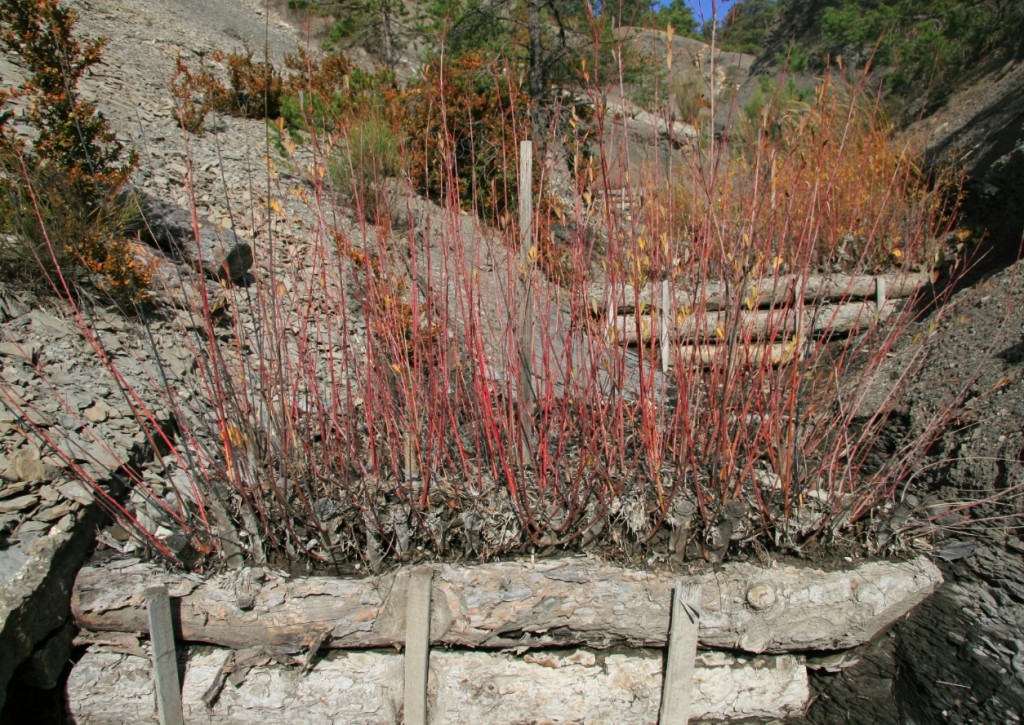Scientists are building walls of willow trees in the Southern French Alps gullies to trap dirt that blocks hydroelectric dams downstream.
Sediment in rainwater washes off the steep valley slopes in the Francon marly basin into gullies. These smaller waterways then feed larger rivers. When the water reaches the slower-moving reservoirs above dams, the sediment drops out and settles behind the barrage.
This can cause big problems as dams are only engineered to withstand a set about of force pressing against them. If this is not removed periodically, the dam can eventually burst or overflow. So the muddier the river, the faster the build up. Every 15 years, energy companies in must pay millions of euros to scoop out the mounds of dirt.
Freddy Rey and colleagues are adapting ancient bioengineering systems, high up in the mountains, to prevent the amount of sediment reaching the dam. Willow cuttings are buried 30cm within wooden walls that stretch across the channels. These are placed roughly every three meters up the gully like a staircase.
Similar to a sieve, the willows allow water to flow through but trap the sediment back. Within a year, these structures can trap up to 10cm of sediment. Over time, this increases as the willows become more established and more sediment can be kept back. After 20 to 30 years, the vegetation will have complete cover and sediment erosion is almost completely stopped.
In with the new
Rey and his colleagues figured that instead of trying to prevent erosion on the banks of the gorges, it was cheaper to plant the walls actually in the gully base. “The sediment is eroded off the slopes but is instead trapped in the gully floor,” says Rey. In the long run, the bioengineering works out more cost effective.“It costs 15 Euros per m3 of sediment to scoop dirt out of the dam and this has to happen every 15 years,” says Rey. “The willow walls however have a one off cost of four Euros per m3. Once they are in – they don’t need to be replaced.”
Looking back in time
The work presented at the EGU only started in 2002 and so in early days. The team needed to see how reliable these structures were and if they hold out in the long term and especially during intense rainfall. They looked for evidence in similar structures, using Austrian black pine plantations, that were used 136 years ago to stop soil erosion caused by agriculture.
“If you dig down into the sediment of these old walls – you can see the original gully shape and the result of 150 years of action,” says Rey. “We know there has been heavy rainfall during this time and so know the structure have stayed in place.”
Location, location, location
The walls in this research were placed in gullies in the Francon catchment, spanning an area of around 50,000ha. However, the structures must be strategically placed. If conditions are too dry, for example, the cuttings cannot get established into saplings and sediment trapping is ineffective.
‘‘It is really important to find the right places,” says Rey. “Even in France, if the aspect is to the south we can have problems.”
Other experiments are using cuttings from different species such as Popular (Populus nigra) and rooted plants such as Seabuckthorn (Hippophac spp.) to see if the amount of dirt trapping can be increased.

The scientists are experimenting with the best time of species for the walls. Picture courtesy: Freddy Rey
by Becky Summers, City University, London



BECU
Will the deep roots of verticer grass tk away much nutrient.? When we remove it, how the roots affect the soil loosen?
Jacob
Creating terraces on the hillsides to stop that erosion is the next step
abdelgalil malakal musa
Great Idea thanks
MTeachman
When the sediment has filled the gullies and with the probability that other plants will grow over and around these sediment dams, will water flow be reduced?
Is there any ongoing maintenance required of these?
Depending on the amount of water and the force with which it flows, is it expected that the water will travel a new pathway which will also require sediment management?
Judi
Water flow will not be reduced. The speed of the flow will be reduced somewhat, but should remain in the main channel. Over time the sediments will provide new habitats for new plants and critters.
khan
Great stuff, beautiful pictures.
khan
Great idea…thank you for posting
Andreas
Such a horrible design
Charlie
What is that? Inquiring minds want to know. I am thinking that this will work in a ravine behind my house that gets water from road above and washes debris into my collection pond which stops up my pipes and overflows the driveway. Every year or two I have to redo everything I have done to keep the water at bay.
L. Oustatcher
Great idea…thank you for posting
David Maher
Brilliant, over time you could see how willows could act as first succession pioneers ,building soil and fertility. Habitat for birds, insects will increce bringing in seed and over time the whole gully will be transformed to ecological health. Very Nice Work, Well Done.
Mark Mier
Great stuff, beautiful pictures.